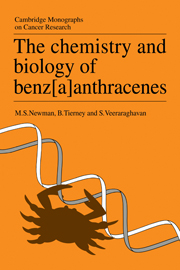8 - Metabolism
Published online by Cambridge University Press: 07 September 2010
Summary
Introduction
Polycyclic aromatic hydrocarbons are metabolized by the mixed function oxidase system to forms more readily excretable by the cell; usually by making the PAH more polar and therefore more water soluble. The principal enzymes involved in this process are those consisting of the haem-containing cytochrome P-450 (which requires both NADPH and molecular oxygen) and epoxide hydrolase. These enzymes are located mainly as membrane-bound proteins in the endoplasmic reticulum or nuclei of cells although some cytosolic forms are known. They exist in ‘multiple forms’ some of which have been isolated and purified. These isoenzymes, which are present in a variety of tissues, can be selectively induced by treatment of the animal with various chemicals (commonly used cytochrome P-450 inducers are 3-MC and phenobarbital), and these various induced states can result in different metabolic pathways for the compounds under study.
Cytochrome P-450 introduces a hydroxyl group into an alkyl group, or an epoxide group across the double bond of an aromatic system. Epoxide hydrolase can then metabolize the epoxide further to a trans-dihydrodiol. If this trans-dihydrodiol contains an adjacent double bond then cytochrome P-450 may act for a second time to form a diol epoxide. Although these events are designed as detoxification routes current evidence suggests that the formation of a diol epoxide, particularly a bay-region diol epoxide, are in fact steps of metabolic activation.
- Type
- Chapter
- Information
- The Chemistry and Biology of Benz[a]anthracenes , pp. 87 - 112Publisher: Cambridge University PressPrint publication year: 1988



